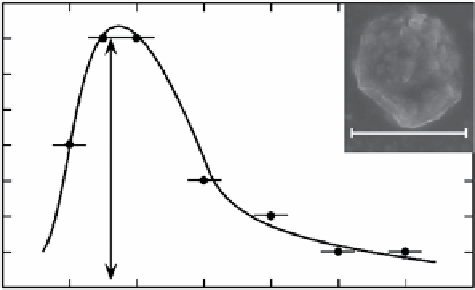Geology Reference
In-Depth Information
8
Figure 6.7
Figure from Latta
(2005) showing a magnetite
grain analyzed by SEM/EDX
in upper right corner. The
grain is iron oxide with quartz
coatings suggesting quartz
cement and a detrital origin
for the grain. Graph shows
grain size measurements and
average grain size of 3.3 ± 1 µm
that is consistent with that of
far-traveled atmospheric dust
particles.
7
6
5
4
3
μ
m
3
2
1
0
0
2
4
6
Particle size (
μ
m)
8
10
12
14
observation that the amplitude envelope of the log
10
ARM series filtered at the
precessional scale (Figure 6.6) shows evidence for not only the long eccentricity
period (~400 kyr), as expected based on the tuning, but also short
eccentricity.
What is most interesting for the Cupido Formation is that the rock magnetic
measurements clearly encode orbitally forced climate cycles, but the upward
shallowing facies cycles do not. The lithologic cycles were quantified by
Hinnov et al. (2013) for spectral analysis by using the standard technique of
assigning “facies ranks” for depositional depth. The data sequence for this
rank series is tied to time in the same manner as the rock magnetic data series,
by assigning the fourth order sequence boundaries to indicate 405 kyr long
eccentricity. While Milankovitch periodicities were observed in the rock
magnetic parameters, the rank series saw spectral peaks emerge with periods
of 180, 72, and 58 kyr, not orbitally forced periods, indicating that the litho-
logic variations are not driven by Milankovitch global climate cycles.
The suggested encoding mechanism for the Cupido Formation is based on
observations that Latta et al. (2006) made on magnetic separates for these
rocks. Diana Latta examined the magnetic extracts under an SEM and saw
quartz coatings of the original quartz cement on the magnetite grains sug-
gesting that they are detrital in origin (Figure 6.7). Furthermore, a grain size
analysis based on visual examination of the extract indicated a median grain
size of 3.3 µm. The SEM observed grain sizes are consistent with the hyster-
esis parameters indicating MD and PSD magnetite grains. Latta et al. (2006)
interpreted this information to indicate an eolian origin for the magnetite
grains for this platform carbonate depositional environment. Based on the
paleolatitude for the site (15°N) and paleogeographic reconstructions for this
time in the Cretaceous, Hinnov et al. (2013) and Latta et al. (2006) both came
to the conclusion that aridity driven by variations in monsoon strength were
controlling the supply of dust to the depositional basin. The source of the
dust was most likely northern Africa given the expected global wind
circulation for the Cupido's paleolatitude.

